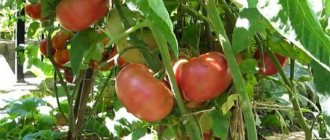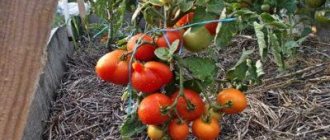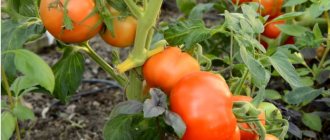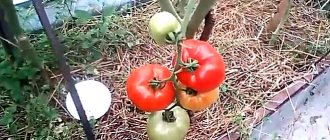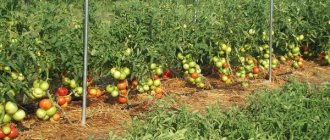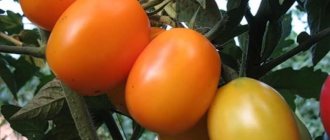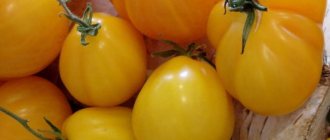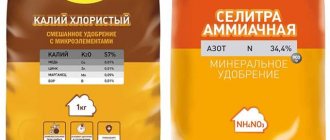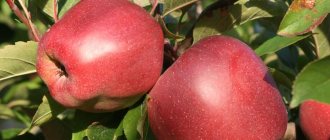What is included in the concept of a determinate variety?
Determinant is a concept from linear algebra.
Its literal translation means “determinant”. When applied to plants, the name determinant means definite. growth stops with the appearance of a flower cluster at the top.
For gardeners who do not strive to grow tomatoes on an industrial scale and want to get an early harvest, determinate tomatoes are the ideal choice.
If the goal is to get as many fruits as possible, the choice is indeterminate (unlimited growth) varieties.
Find out more in the video below:
Determinate tomatoes: what are they?
What is a determinate variety of tomatoes: this name hides varieties in which the formation of a flower cluster begins after the 5-7th leaf, and subsequent growth continues due to the strongest shoot (stepson). Determinate tomatoes do not grow indefinitely. They tie 4-8 tassels, and the bush stops growing.
The difference between determinant varieties and others and their advantages are as follows:
- early fruiting;
- quick yield of the crop;
- good yield;
- shorter period of care.
They also have certain disadvantages:
- limited growth processes, which affects productivity;
- carrying out stepsoning technique;
- periodic application of fertilizers;
- susceptibility to disease.
On a note. What does the word determinate variety of tomatoes mean in Latin? “Determination” is translated as limitation or limit. Tomatoes stop growing when they reach a certain height.
When sellers are asked: “Determinate tomato - what is it?” – the answer is clear: low-growing plants. But this is not an entirely correct definition, because size restrictions do not mean short stature.
The main differences between determinate and indeterminate and other tomatoes
Sometimes seed sellers indicate in the annotation: low-growing, medium-growing or tall-growing. This definition is erroneous and misleading to inexperienced gardeners. Among the indeterminate varieties there are low-growing ones. Determinate tomatoes, bred specifically for growing in greenhouses, are distinguished by tall stems.
The main difference is not the height of the plant, but its development during the formation of flower clusters. Indeterminate tomatoes grow upward and bear fruit throughout the season. Determinate ones have the peculiarity of stopping growth when a certain number of inflorescences are formed.
Openwork F1
It is considered one of the best determinate tomato varieties for greenhouses. It belongs to the same variety as Bourgeois and has the same growing season. Grows up to 90 cm. It was bred specifically for growing in greenhouses in the northern regions of Russia. In the south it is grown outdoors. One of the main advantages of this variety is its high yield. It forms ovaries in bunches, each of which contains 5 fruits, and there are usually about 4 bunches on one branch. Tomato fruits are medium-sized, weighing about 280 g. Productivity from one m2 to 12 kg. A variety for universal use. Like any high-yielding plant, it needs organic and mineral fertilizing. Step-sonning is necessary.
How are the seeds different?
When choosing seeds, you should pay attention to the manufacturer’s instructions - pure variety or hybrid.
Preference should be given to hybrids. They have high productivity and early maturity, resistance to diseases.
Adapt better to changes in climatic conditions. The most important thing is to determine the timing of sowing.
In different regions, seeds are planted at different times. For the middle zone, sowing dates:
- indeterminate tomatoes – early March;
- semi-determinate - mid-March;
- determinant - end of March.
Peculiarity! The seedlings differ in the height of the cotyledon. In determinate varieties it will stretch only 1-2 centimeters, in indeterminate varieties it will be 4-5 centimeters.
Varieties for the Middle Zone
To achieve early ripening of fruits, it is advisable to grow them in protected soil. Ripening occurs 2-3 weeks earlier than when grown outside. In the middle zone, you can plant tomato seedlings in a greenhouse from mid-April, as soon as the soil warms up well after winter. Before planting, it is better to fertilize the soil with humus, peat and ash, then the seedlings will quickly take root and begin to actively bear fruit.
Alpha
For greenhouse and outdoor planting in the central zone of the country, gardeners choose the Alpha variety. The variety is unpretentious in cultivation, grows well in outdoor conditions, and does not take up much space on the site. Determinate bush, 50 cm high, with a thick stem. The bushes tolerate spring frosts well and are not susceptible to disease. The fruiting period begins early, after 60-70 days from the formation of sprouts, the yield indicator is 7 kg/m2.
The tomatoes are small in size, weighing 60-70 g. The shape is flattened, the skin is red, glossy. The skin is durable and protects the flesh from cracking. Tomatoes are suitable for long-term storage; in cooking they are used for cutting into salads. The advantages of Alpha are:
- early ripening period;
- strong immunity;
- marketability;
- compactness of bushes.
Alpha has no disadvantages; the variety is loved by gardeners and is very popular not only in Russia, but also in Belarus and Ukraine.
Aphrodite
Under the film, determinate plants reach a height of 90 cm. Few stepchildren are formed, the bushes have average foliage. The hybrid produces red fruits within 90 days from the start of cultivation. The weight of the fruit is from 90 to 110 g, the taste is sweet and sour. Aphrodite is grown for fresh consumption and for pickling. Productivity – 5-6 kg/m2. The variety exhibits high resistance to late blight and powdery mildew.
The Aphrodite variety has many positive qualities:
- attractive appetizing appearance;
- long-term storage;
- possibility of long-distance transportation;
- universal use.
Aphrodite accepts organic and mineral supplements well, and its taste improves.
Attention! A garter to a tomato trellis is recommended if the bushes exceed a height of 70-80 cm.
Valentina
A determinate variety with an early fruiting period, which has proven itself to be planted among gardeners, is Valentina. Ripening occurs approximately 3 months from the moment of sowing the seedlings. Valentina is grown in a greenhouse, but the variety is suitable for outdoor soil. Plants with excellent immune properties, viruses and pests are not afraid of them. The yield indicator is at least 10 kg/m2. The variety is easy to plant and easy to care for.
Oval-shaped tomatoes are colored red. The taste is standard for the culture, sweet and sour. Valentina is mainly grown for canning, since the skin is dense and not prone to cracking. The tomatoes are beautiful, small, weighing 100 g, and easily fit into a jar of any size. The advantages of Valentina are:
- resistance to late blight and other diseases;
- early and abundant fruiting;
- compact bushes up to half a meter high;
- unpretentiousness in cultivation.
Disadvantages include the mediocre taste of the fruit and a slightly harsh skin.
The best pickling five If you love canning tomatoes, then you will definitely need a selection of the 5 best varieties of tomatoes for pickling. They…
The difference is in the seedlings
The age of the seedlings is of great importance.
Determinate varieties are planted in a permanent place 55–60 days after sowing. Indeterminate ones are ready for planting later - after 65–75 days.
The type of future bush is determined by the seedlings. On the determinate, the brush is tied with the appearance of the 5th or 6th leaf, on the indeterminate after 8-10. Some varieties of determinate tomatoes can be planted without going through the seedling stage directly into the ground.
Growing tomatoes with two roots (ablactation)
A plant with a strong root system, being able to obtain more nutrients from the soil, will set more fruits and be able to grow them larger. You can increase the root system by additionally sprinkling the tomato stem or lower stepsons with soil, or you can grow a tomato bush “on two roots” and learn how to graft at the same time. Experts call this method ablation.
Important! It can only be done with the seedling method of growing tomatoes, since grafting is done on very young and still short plants.
It is simply inconvenient to carry out ablactation on young tomatoes growing in the ground.
Tomato seeds are planted in separate pots, two in each. Plant the seeds no further than a centimeter from each other.
When the tomato seedlings reach the required size: the stem at the grafting site must be at least 4 mm, you can begin ablation.
Carrying out ablation
Using a very sharp razor, you need to remove the bark from the tomato stems in the place where the plants will touch. The length of the area with the bark removed is 10-15 mm. The cambium must not be damaged.
If you have a steady hand and you are sure that you will not cut off the entire stem, you can make oblique cuts 6 mm long and no more than half the stem in depth at the point of contact. For a rootstock, the incision is made from top to bottom, for a scion, vice versa. After which the tongues of the incisions are aligned with each other with their inner sides and fixed. This method is suitable if you have already decided in advance which of the plants you will remove or if you are going to grow a tomato bush with two stems.
If it is not yet clear which of the sprouts is better, you can, without making cuts, tightly wrap the cut points with the exposed cambium to each other with a fixing tape. Immediately before planting tomatoes in the soil, it will be possible to finally determine which of the sprouts is weaker and remove it. Or pinch the tops of both sprouts and grow the bush into two stems.
It is better to wrap the stems with some kind of “breathable” material, such as a strip of non-woven material or a bandage. It is better not to use “non-breathable” material. A tomato is a vine, and in this case, the stems will take root under the bandage. The stems grow together within two weeks.
The tomato bush grows much more powerful and prolific, so that during further work not to damage the plant, the support must be installed simultaneously with planting the tomato seedlings.
Ablation on the ground
A similar operation can be carried out on tomatoes already planted in the ground. But in this case, tomato varieties that produce stepchildren are used, since in fact, in such conditions, it is not the stems of seedlings that grow together, but the stepchildren of neighboring bushes.
This is interesting: Rules for caring for Ficus Benjamin Natasha at home
The scheme is generally the same. It is distinguished by the need to immediately put up supports, attaching stepsons to them below and above the scion site. Below the grafting, the stepsons are attached separately for ease of work. Above - together. For insurance, both stems are also secured just below the point of fusion, so that the branches do not separate and the efforts are not wasted.
In the splicing area, it is better to remove leaves for better ventilation and ease of manipulation.
Important! Tomato stems thicken as they grow, so the straps must be loosened periodically so that they do not cut into the stem and block the plant’s ability to receive nutrients.
As with the merging of two bushes, if the fused stepchildren are planned to be grown into one stem, the rootstock or weaker stem is removed. If at two, then the tops of both stepsons are pinched.
Not all determinate varieties of tomatoes have stepsons for using the second option of ablactation, so it is better to carry it out by merging the main stems of two young tomatoes.
Have a good harvest!
Types of determinate varieties and hybrids
They are conventionally divided into four types. They differ in growth, number of flower clusters, ripening time and yield.
Semi-determinant
Due to the fact that this species has mixed properties, it is sometimes confused with indeterminate varieties. A height of 1.5 to 2 m allows for more efficient use of greenhouse space. Gartering is a must.
The first inflorescence appears after 7-8 leaves on the main stem and 3-5 on the lateral ones. Typically 10 to 12 clusters are formed, after which the central stem stops growing. The next brushes are laid after 2, rarely – 3 sheets.
The advantages of this species: high resistance to diseases, productivity and excellent fruit quality.
Semi-determinate varieties and hybrids are intended mainly for growing in greenhouses. Find out which varieties are suitable for greenhouses.
Interesting! Common varieties are Eagle Beak, Monomakh Cap, hybrid Gravity.
Determinant
They are distinguished by fleshy leaves and dense short stems.
The formation of flower clusters is similar to semi-determinate plants, but the formation of the first begins after 6-7 leaves.
Growth stops after the appearance of 5-6 shoots with tassels. The brushes form 6-8 fruits.
The bushes are low-growing - up to 1 meter in height. These are usually early and mid-ripening varieties and hybrids.
Compensates for low yield compared to indeterminate varieties by high planting density - from 4 to 6 bushes can be planted per 1 square meter.
The first two clusters leave 3-4 fruits. All deformed ovaries are removed.
Interesting! Popular: May Early, Olya F1, Honey Spas.
Superdeterminant
Early ripening varieties and hybrids. Flower racemes grow through 1-2 leaves. Formed after the first 6-7 sheets. The upper brush, limiting the growth of the plant, appears after the development of 4-5 brushes on the stem at a height of up to 0.5 m. They do not require pinching or tying.
Note! The most common: Hybrids of the White filling, Siberian early ripening, Agata varieties.
Supersuperdeterminant
Early ripening and ultra-early ripening dwarf varieties with strong stems. Plant 2-3 inflorescences without waiting for intermediate leaves. The first brush may appear after 3 sheets.
3-4 brushes are formed, then growth stops. Height 30-35cm. Bush formation is not required. Usually planted in open ground. Minimal care.
Interesting! Harvest dwarfs: Superclub, Red Pearl, Gigolo.
Varieties for the Urals
Tomatoes are successfully grown both in outdoor soil and under film cover. This does not affect the ripening period too much; it may differ by only a couple of weeks. Seedlings are prepared from the beginning of spring; by April the bushes should reach a height of several cm so that they can be transplanted into the greenhouse. Outdoor planting in the Urals begins in early May; you need to wait until the frosts stop at night and warm weather finally arrives in the region.
Benito f1
The product of Dutch breeders was a hybrid with early fruiting and low-growing bushes.
Mostly plants are planted outside, but greenhouse cultivation is possible. The yield is high and amounts to 8 kg per bush. Bushes up to one meter tall, not spreading, neat. Stepson formation is moderate, the plant grows in 2-3 stems. Resistance to diseases is good: there are no cases of infection with late blight, blossom end rot and other viruses. Tomatoes are ideal for canning and freezing. Benito's positive qualities are called:
- strong immune ability;
- high yield;
- cold resistance;
- compactness of plants.
Disadvantages include mediocre taste and harsh fruit skin. To improve the taste characteristics, fertilizing with potassium fertilizers is recommended.
The best determinate varieties of tomatoes
"Eagle Beak"
One of the most unpretentious and tasty mid-early large-fruited varieties. Attractive shape, crimson color. The fruits are stored for a long time and ripen well. Tall. Grown in greenhouses and open ground. Resistant to frost. Non-self-pollinating.
"Honey Saved"
An unpretentious, proven and reliable mid-season variety. The sweet, classic heart-shaped fruits are orange when ripe. Easily tolerates temperature changes. Tall, requires garter to a support. When grown in open ground, most of the fruits ripen on the vine. A very tasty juice is obtained from the fruits.
"Max"
A promising early ripening determinate variety. The fruits are large, dark red. The taste is excellent. Requires staking and pinching to increase fruit size and speed up fruiting.
"Newbie"
Mid-early variety. Outdoor cultivation is recommended in the southern regions. The bush is compact, medium branched. Resistant to overripening and mechanical damage. Used for canning and juice production. The fruits are medium-sized and orange-red in color. No pinching or gartering required. Resistant to root-knot nematode.
"Bourgeois Hybrid"
Hybrid for open ground and light greenhouses. Mid-season, tall. Resistant to diseases and temperature changes. It produces a lot of fruit in any weather conditions. Shade-tolerant. The medium-sized red fruits last up to 2 months. Garter and bush formation are required.
Varieties for Siberia
Spring warmth comes to Siberia later than to other regions, so there is no need to rush even with greenhouse planting. If you plant seedlings ahead of schedule, you may not get a harvest at all. The recommended time for replanting plants in protected soil is the 20th of April. Tomatoes are planted outside no earlier than the beginning of May, when the temperature at night does not drop below 7-8 degrees Celsius and the ground becomes warm.
Parodist
Parodist, a determinate variety with an extremely early fruiting period, grows well under a film in a cold climate zone.
Ripening occurs 2.5 months after the start of growing seedlings. The height of an adult plant does not exceed half a meter, but a garter to a support is necessary. Form a bush with 2-3 stems. The yield is low, but stable - 2 kg per bush. The variety is resistant to late blight, cladosporiosis, and fusarium. The bushes are not afraid of frost and are successfully grown even in open ground, according to reviews from gardeners. This is interesting: What are the benefits of chamomile for the body?
Parodist produces fruits of good quality with a sweet and sour juicy taste. Vegetables are often used for salad purposes and are suitable for pickling and pickling. Tomatoes weigh 110-150 g, the color is bright red with gloss. Tomatoes look appetizing, are stored for a long time and are easily transported. The advantages of the Parodist include:
- strong immunity;
- ease of care;
- good taste;
- early fruiting.
Attention! The variety does not like dense planting, so there is no need to place more than 3-4 plants per 1 square meter.
Far North
Low-growing, early-ripening tomatoes include the Far North variety.
After 3 months, the first red tomatoes are harvested from the vines, in the amount of 2-3 kg per plant. Plants normally survive cold spells, so even in Siberia they can be planted outside; the variety is suitable for greenhouse cultivation. The height of the bushes does not exceed half a meter; tying is not necessary. The Far North rarely gets sick and is not affected by viral diseases or fungal infections. Each tomato cluster contains 5-8 red fruits of equal weight, approximately 100 g, and equal size. The fruits are of a standard round shape, the pulp consists of 4 chambers, the taste is sweet and sour with a high content of juice. The purpose of tomatoes is universal; they are suitable for any purpose. The positive qualities of the variety are:
- early ripening;
- good transportability;
- strong immunity;
- resistance to frost.
The Far North has no disadvantages; on the contrary, the variety has proven itself for planting and has received recognition from many gardeners not only in Siberia, but also in other regions.
Torbay f1
The Torbay hybrid was bred not so long ago, although gardeners have already fallen in love with it for its low, compact bushes and unpretentiousness in propagation.
The height is 85 cm when grown outside; in a greenhouse the bushes grow up to a meter. Fruiting occurs abundantly after 2 months from planting seeds to seedlings. Torbay is resistant to powdery mildew, tobacco mosaic virus, and late blight. The yield indicator is 6 kg/m2. During ripening, tomatoes change color from green to pink. The taste is mostly sweet, but there is a pleasant sourness. The harvest is used for canning and fresh consumption. Tomatoes are perfectly ripened at home and can be stored for a long time. The advantages of Torbay are:
- long-term preservation;
- good taste characteristics;
- strong immunity to diseases;
- ease of planting and further cultivation;
- simultaneous early maturation.
Torbay does not like drought, does not tolerate heat and lack of moisture. Watering should be frequent and regular.
On a note! For irrigation use cool, settled water with low hardness.
For open ground
"Sanka"
Very early, 30-60 cm high. The fruit is round, slightly ribbed red. Resistant to cracking. It develops and bears fruit well in low light and low temperatures. More about the Sanka tomato
"Alpha"
Can be planted directly into the ground, bypassing the seedling stage. In the south, the fruits ripen in early summer, in the north - in mid-July. The period from planting to ripening is 85 days. The variety is resistant to diseases. The fruits do not tolerate transportation well.
“Superbomb” Mid-season new product for open ground. Resistant to weather changes. Requires intensive feeding and pinching. The fruits are large, fleshy, 5-6 per cluster. Gives a decent harvest in open ground.
"Explosion Hybrid"
Superdeterminate hybrid of tomatoes, can be grown without seedlings. Not afraid of frost and sudden temperature changes. It grows poorly in greenhouses.
Low-growing varieties without pinching
There are quite a lot of varieties of tomatoes that do not require pinching, the most popular of which are:
- White filling is an unpretentious, cold-resistant, early-ripening plant, grows up to 47-51 cm, and bears fruit regularly. The weight of one tomato is approximately 80-130 g, the shape is round.
- Moment is an ultra-early ripening species, in which tomatoes weighing 70 g grow in 94 days. The height of the bush is 25-40 cm.
- Orange is a tomato with semi-spreading bushes resistant to root and blossom end rot. The fruits ripen on days 97-103, the weight of one is approximately 100 g.
For greenhouses
"Alsu"
Early ripening. High resistance to diseases. Large fruits with excellent taste and long-term storage. Requires a garter.
"Spring of the North Hybrid"
Early ripening. Pinkish fruits of medium size, pink in color. The pulp is fleshy and juicy.
"Pride of Siberia"
Early ripening. Height up to 1.5 m. Fruits are very large. The variety was bred for greenhouses, but in the southern regions it can be grown in open ground. It is resistant to diseases. Selected fruits with excellent taste.
"Big Mama"
Fruitful and promising early variety (vegetation period 85 days). Resistant to late blight and powdery mildew. The fruits are large, have good taste, and are resistant to cracking. Universal in use.
"Doll Hybrid"
One of the best varieties for growing in greenhouses. Plant height is 65-75 cm. The bush must be tied up. Fruits have a long shelf life. The pulp is sweet and fleshy.
Alpha
Determinate tomato variety of early ripening, standard type. Excellent for growing in cold climates. It grows up to 55 cm. By the way, this variety can be sown directly into the ground, bypassing the seedling period. In this case, fruiting will begin on the 85th day. In the middle zone they are grown in open ground, and in more northern areas - in film shelters. In the southern regions, the first tomatoes are obtained at the beginning of summer, in colder regions - at the beginning of July. The fruits are small in size, weighing 55 g, round in shape. The yield per bush reaches 7 kg per 1 m2. The variety has strong immunity to various types of diseases. In addition, the appearance of the most dangerous ones, such as late blight and fungal diseases, causes the harvest to fail.
Stepsoning
The main harvest of determinate tomatoes is the fruits of the first 3 inflorescences. To speed up ripening, small shoots are broken off and the shoots are pinched.
When forming a bush, leave 1-2 side shoots near the main stem and tie it under the first brush. Leave 3-4 clusters on the central stem. 3 brushes are formed on the side shoot, after which it is pinched.
Subsequently, new shoots are formed to continue the growing season. In this case, timely feeding is necessary.
What types of determinate tomatoes are there?
This tomato variety is divided into three varieties. They differ from each other in the ripening period, varietal characteristics and have different ripening periods:
- Semi-determinant . They have characteristics of low-growing and tall-growing varieties. They stop growing after the appearance of the tenth cluster with ovaries, each of which contains two or three leaves.
- Determinant . Unlike the first group, the first brush is formed not above 7-8 leaves, but above 6. The main shoot stops growing when the flower brush appears.
- Superdeterminant . This variety is also called standard. The main distinguishing feature of this group is the rapid ripening, low growth of the bush and a powerful, developed stem. The tomato stops growing when 3-4 flower stalks are formed. On standard varieties, 2-3 fruiting clusters may be formed, devoid of leaves. The first brush is laid above the fifth leaf.
There are differences between these groups, so it is necessary to take into account the characteristics of each.
Possible errors during cultivation
- Planting a variety for a greenhouse in open ground and vice versa.
- Incorrect watering.
- When forming the bush, pinching and pinching of the top were carried out at the wrong time
- Ignoring disease prevention.
- Formation of uneven ovaries, breaking of the bush under the weight, late blight of tomatoes, due to the fact that the bush is not tied up correctly.
- Growing in unventilated greenhouses leads to a cessation of pollination and barren flowers. At temperatures above +33 degrees, tomato pollen becomes sterile and fruit set does not occur. Non-self-pollinating varieties do not produce ovaries.
- Planting too thick.
- Excessive feeding.
Whether or not to grow determinate varieties depends on what result you want to get.
What is a determinate plant?
Many people wonder what it means - determinate tomatoes. It is more common to hear undersized tomatoes than determinate ones. But this is one and the same thing, with the difference that the word “determinant” is an official group of varieties, characterized by low growth and some other features. They can be grown not only in open ground, but also in a greenhouse. Such plants are considered economically profitable, since they take up little space with a large harvest.
Most often, low-growing plants are grown in the northern regions, although they grow well in all regions of the country. Special care requirements include tying some varieties so that they do not fall to the ground. In this position it is easiest to care for the bushes.
Features and differences of tomatoes
Tomatoes are among the most common vegetables to grow. They contain a lot of useful elements, in particular lycopene, a powerful antioxidant that reduces the risk of formation and prevents the proliferation of cancer cells.
Tomatoes also contain a large amount of vitamins and microelements necessary for humans: serotonin, phytoncides, chromium. Serotonin is a well-known “happy” hormone that improves mood. Phytoncides are plant substances that inhibit bacterial growth. And chromium promotes rapid saturation, which, by the way, makes tomatoes an excellent product for dietary nutrition.
There is a theory that foods that are similar to a certain part of the body have a positive effect on that organ. So, heart-shaped tomatoes reduce the risk of developing cardiovascular diseases. In addition, they improve digestion and are useful for asthenia, atherosclerosis, and azotemia.
But not all people can eat tomatoes. For example, they are contraindicated for older people suffering from bone and joint diseases. This is due to the fact that frequent consumption of tomatoes leads to the accumulation of calcium and salts in the body. Therefore, excessive consumption of tomatoes is contraindicated for all people. It is recommended to eat no more than 200 g of this vegetable per day.
Another disadvantage is that tomatoes contain a large amount of acids. They can provoke spasm of the gallbladder.
There are several types of tomatoes. Let's look at this issue in more detail.
Determinant
Determinate – varieties whose growth is limited. These tomatoes have many advantages:
- limited upward growth involves the development of strong lateral stepsons that bear fruit, which makes such varieties high-yielding;
- one-time fruiting - determinate tomatoes produce a large harvest that does not stretch over time;
- early fruit ripening;
- adapt well to open ground;
- limited growth spares the gardener from tying up and replacing supports.
But the variety also has some disadvantages:
- limited growth leads to limited yield, that is, the yield is lower than that of indeterminate varieties;
- low resistance to diseases.
The most famous determinate varieties of tomatoes are Sakhalin, Ladies' Man, King of Early and Golden Heart.
Indeterminate varieties can grow very tall
Indeterminate
Indeterminate varieties have unlimited growth. They also have certain advantages:
- high yields from a small area of land - due to the high growth of individual plants;
- long fruiting period: in open ground they produce crops until the weather gets cold;
- resistant to most diseases.
But we cannot help but note some disadvantages:
- large growth requires special care: plants must be constantly tied up using high supports, good lighting and air exchange must be provided;
- it is necessary to remove all the stepsons so that the nutrients go to the formation of the main stem;
- They perform well in greenhouses, but in open ground in regions that are not hot enough they ripen quite late and bear less fruit.
Indeterminate tomatoes include such popular varieties as Babushkin Secret, Bull's Heart and Chernomor.
Standard
These are compact plants with one short and thick stem. They do not require specific care: no need to pin or tie them up. They produce a good harvest, but the tomatoes are usually small.
Standard tomatoes include Snow White, Riddle and Moskvich.
Superdeterminant
Superdeterminate tomato varieties are the fastest ripening. They are ideal for those who want to get an early harvest without much effort.
These varieties do not require pinching. Also, due to its short stature, a garter is not needed. The downside is that, after harvesting once, you can’t expect more fruits from super-determinate varieties.
Popular varieties of superdeterminate tomatoes are Children's Sweetness, Alaska and White Bulk.
Semi-determinate tomatoes
Semi-determinate varieties combine the properties of determinate and indeterminate varieties. They have an average height, which allows you to harvest a large harvest from one plant, but without putting in much effort, tying and pinching the bush. In this case, the fruits are formed throughout the growing season.
It is preferable to grow such tomatoes in greenhouses.
The most popular hybrids of this type of tomato are Yvette F1, Gravity F1, Red Arrow F1.
Indeterminate and determinant: differences
Every experienced gardener knows how to distinguish a tomato variety for greenhouses or open ground even before the fruits appear.
Seedlings
As soon as the first shoots appear after about 4 days, you can indirectly determine the type of tomato bush. The length of the cotyledonous knee in indeterminate species is from 3 to 5 centimeters, in determinate species - from 1 to 3 centimeters. Lack of lighting can complicate the recognition task. After all, it is precisely because of it that the seedling stretches strongly upward.
Seedling
The type of tomato can be determined as soon as the first flower cluster appears on the seedlings. The formation of the first cluster on determinate tomatoes for greenhouses and open ground begins after 6-7 leaves and below, but on indeterminate tomatoes - above 8-9.
Adult tomatoes
After a certain time, after planting the seedlings in the ground or growing them in a greenhouse, you will develop adult plants - bushes. They must be cared for in a timely manner and pinched in order to collect many ripe fruits in the future.
When several ovaries appear, the type of tomato can be determined. The best determinate varieties have no more than 3 leaves between the racemes, while indeterminate varieties have more than 3 leaves.
Sometimes, when growing indeterminate tomatoes, the shoot, which is located behind the flower cluster, is pinched. Thus, it may seem that its growth ends at this point.
There are varieties of tomatoes for growing in a greenhouse that in all respects fit the description of an indeterminate variety, but in fact are determinate. These are exactly the exceptions that we talked about earlier - hybrids.
There are also varieties for greenhouses, known as standard indeterminate varieties. This variety is characterized by its small height. It is intended for keeping in a greenhouse, but not for soil.
The standard type of plant does not branch, does not need garter or support, it does not need to be pinched, it has a massive and very strong central stem that can withstand a huge load in the form of a large number of fruits.
Caring for indeterminate tomatoes
These varieties of tomatoes are convenient to grow in the southern regions. They are usually cultivated in greenhouse conditions, but it is also possible to harvest them in open space. Gardeners in the northern regions do not have this opportunity, because such tomatoes have a long ripening period. Given the height of the indeterminate plant, its stem must be tied up so that it does not break under the load of the harvest.
As the bush grows, it becomes necessary to constantly remove stepsons so that a stem can form. When removing shoots, leave a small stump so that a new branch does not begin to form. The first cluster appears above the 9th leaf, so the harvest ripens later.
How to distinguish between determinate and indeterminate varieties at all stages of growth
They can be easily distinguished even before the first flowers and fruits appear. In the emerging seedlings, the cotyledonous knee straightens out on the 4th–5th day. By its length you can usually approximately determine the type of future bush. In determinate tomatoes, the knee is 1–3 cm, and in indeterminate tomatoes – 3–5 cm. However, when there is not enough light, the seedling of low-growing varieties can stretch out more than is typical for it in good light, and then it will be quite difficult to determine the type of bush.
You can very easily determine the type of future bush by the appearance of the seedlings that have their first flower cluster. In determinate varieties it grows after the formation of 6–7 true leaves and below it, and in indeterminate varieties – 8–9 and above this leaf.
It is easy to determine the identity of the bush in adult plants. True, when they have been planted for a long time, have grown well and already have several clusters with fruits attached, it is not easy to correctly determine the number of leaves before the first ovary. After all, the seedlings could have been buried during planting and then sprinkled, then part of the stem would be underground.
Mature indeterminate plant
It is better to find out the identity of an adult plant in other ways. In indeterminate plants, flower shoots grow every three true leaves. And determinate plants always have fewer than three true leaves between adjacent racemes. In addition, there is always a shoot that has stopped growing due to the ovary appearing at the end. This should not happen on plants of indeterminate varieties.
The only exception is when, during the formation of the bush, the growing shoot was pinched immediately behind the developing flower cluster. In this case, outwardly it will seem that the shoot itself has finished growing and, naturally, an indeterminate variety may be mistakenly mistaken for a determinate one. Therefore, you should be more careful and check the variety by counting the leaves between the ovaries.
It is believed that determinate tomatoes are necessarily low-growing plants, and indeterminate tomatoes are necessarily tall bushes. This statement is only partly true, because there are exceptions.
Among the determinate varieties, there are varieties for greenhouses that form fairly tall bushes, but belong specifically to their own type, because they form flower clusters more often than every 3 leaves. Such tomatoes make up the majority of modern hybrids for greenhouse cultivation. And there are low-growing indeterminate tomatoes, the so-called standard ones, for example, the variety Volgogradsky 5/95, quite well known to many gardeners.
Determinate tomatoes for growing in a greenhouse
Varieties must be highly productive, resistant to fungal diseases, and grow well in closed spaces. The following varieties meet these requirements:
- Orange Princess . Low-growing bushes, if properly cared for, produce up to 40 kg of tomatoes per plant during the growing season.
- Alaska . It is highly resistant to various diseases and is an early variety whose bushes grow up to 60 cm.
- Magus H. An early maturing hybrid with high disease resistance. Large red tomatoes, whose weight reaches 180 g, ripen in 70 days. The variety is stable and high-yielding.
- Raspberry honey . Mid-season variety with sweet, heart-shaped fruits. The bushes are tall and reach 120 cm, but do not have high disease resistance.
- Raja . The bushes of this variety grow up to a meter, and the fruits are fleshy and large with a sweetish taste. Up to seven tomatoes are formed in each brush, reaching 300 g.
- Hazel grouse . The variety grows up to a meter and has red, round fruits with yellow stripes. Tomatoes do not crack. They are good both fresh and for processing.
There are other varieties, but these are the ones that have proven themselves best.
Indeterminate varieties.
Indeterminate means a fairly large size. Simply put, tomato varieties under this definition are capable of reaching very impressive sizes in growth, the ceiling of the greenhouse is not the limit of growth, it can continue further, and new clusters are formed and formation occurs quite efficiently, such varieties have acquired a second name - tall, capable of developing to the limit.
If the conditions are comfortable enough for representatives of such varieties, growth and fruiting can occur throughout the year. The most amazing thing is that each individual bush can grow up to 50 brushes. Before flowering begins, about 10 developed leaves should form. We grow the seedlings for about two months; already 3 months after transplanting the seedlings to a permanent place, you can taste the first ripened tomatoes.
Superdeterminate varieties
Super-determinate varieties are the earliest varieties of tomatoes that do not require pinching. They are usually short-growing and are used mainly for open ground. All varieties are early ripening (85-96 days pass from sowing the seeds to the appearance of the fruits), and the fruits on them ripen simultaneously.
Inflorescences (fruiting clusters) begin to appear when there are 7-8 leaves and are formed every one or two leaves. It happens that inflorescences are formed one after another.
Advantages
- Early ripening;
- They do not require the formation of a bush, that is, pinching;
- Suitable for open and closed ground in any region of Russia, as they are unpretentious to environmental conditions.
Flaws
The fruits ripen almost simultaneously, which requires their quick use: in salads, pickling or for sale. For a large farm, this property is an advantage, but for a small one it is a disadvantage, since it is difficult to use all the fruits at once, and most gardeners prefer the gradual ripening of tomatoes during the season.

